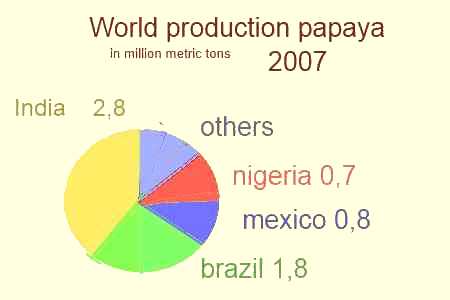papaya
Papaya is a becoming more populair, as it
is a sweet, low in calories and attractiv
colored fruit.
buying a papaya
When shipped the papaya´s are green, as green unripe
papaya´s are firm , so they don´t bruise easely.
But when you buy them the color must be yellow,
brown spots are normal, Smell youre papaya,
as a ripe papaya should have a sweet smell,
if they are unripe they don´t smell at all.
eating papaya
Make sure that they are ripe, for then they
taste much better!
Cut the fruit in two halves, and remove the
black seeds with a spoon. then you can eat them.
papaya seeds
The black papaya seeds have a peppery flavor,
and can be used for salad dressings.
They can be ground up and used a
as a substitute for black pepper.

Papayatree, with ripe fruits.
growing conditions of papaya
Papaya can only grow between the tropics
of Cancer and Capricorn. The growth of papaya
will almost stop if night temperature drops
below 12 grades of celsius.
Optimal temperature 22 - 26 grades of celsius,
papaya dies at temperatures slightly above zero.
Papaya grows on sandy soils that are well drained.
The fruits are susceptible to salty water.
cultivation of papaya
For germination of the seeds, a high ground
temperature is needed.
Papaya is planted in 2 by 2 meter squares
by the use of tissue culture or directly
grown from seeds, in backyards.
No pruning is done.
The high growing cultivars are susceptible to
wind or mossoon damage. Flowering and fruit
develops after a half year, After three
years the fruit production drops.
High nitrogen fertilization is needed to encourage growth
harvesting of papaya
The green fruits are harvested when the have
a slight yellow decolaration on the end.
There is a three years crop cycle, after
the third year the papaya production drops.
unripe papaya
unripe papaya can be used for winter squash or pumpkin.
papain
Papain is an enzym is prepared from immature
papaya's and plays a role in the production
of chewing gums and cosmetics.
cultivars of papaya
important papaya varieties are ´Honey Dew´
'Coorg Honey Dew', is a prolific selection from
'Honey Dew'. The male papaya trees need
to be parly removed.
Pusha Nanha is a variety that can be
planted in high densities.
Papaya Ringspot virus, PRSV
The Papaya ringspot virus is the major threat
to worldwide papaya production.
The virus is vectored by aphids.
By inserting a small part of the PRSV genetic
code into the genome of the papaya the
reduplication of the virus stopped,
a succes story of the agricultaral biotechnology.
So in 1998 the Papaya ´Sunrise´ cultivar became
the first genetic altered food that became
available to human race.
Papaya
Fruit flies
Fruit flies lay theire eggs in fruit,
causing the fruit to rot. It is not very
difficult to kill the eggs and larvae of
the papaya fruit fly, this can be
easely done by heat.
The history of papaya
Papaya´s orignally grow in Panama and are
described by the Spanish chronicler Oviedo
in 1500. The papaya spread fastly into the
tropics in 1600. Papaya was transported to
the Pacific Islands in 1650.
The future of papaya
There is very much room for improvement of
the papaya production. The avarage yield
in India, the number one producer is
about 20 tons/ha or 8 tons/acre.
By using nitrogen fertilizer and more
prolific variaties that are resistent to
disease the yield can be 4 or 5 times
as high, up to 100 tons/ha.

Papaya world production.
world production and export of papaya
India is by far the most important papaya
producer worldwide, and exports to the middle east.
Almost all the states of India grow papaya,
but Andhra Pradesh, Karnataka, Gujarat,
and Orissa are the most important.
Brazil is fastly growing in more export value.
and exports mainly to Europa.
Mexico exorts to USA and Canada.
Other important päpaya producing lands are
Indonesia, Thailand, China, Peru and Philippines,
mut these only produce for there local market.
|
|